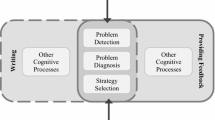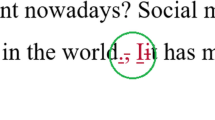Abstract
The purpose of this classroom-based study is to understand the differences and similarities between trained peer written feedback and the teacher-researcher’s written feedback over time and identify key instructional features contributing to them. Using repeated-measures, the teacher-researcher analyzed comment area, function, feature, and type of revision-oriented comments produced by 17 trained freshmen English majors and the teacher-researcher on three writing assignments over a semester. The findings show that despite significant differences in amount and area of comments, trained peer written feedback and the teacher-researcher’s written feedback gradually resembled each other in function, feature, and type of revision-oriented comments over time. Possible factors for the increasing similarity included peer review training, teacher-student conference, provision of guiding questions, observation of the teacher-researcher’s and peer written feedback, as well as a change of the teacher-researcher’s commenting strategy.
摘要
此課室研究旨在了解受訓練後之同儕評論與教師評論之異同,並指出何種教學活動促成兩者間之異同。研究者(亦為此寫作課之教師)蒐集十七位主修英語且受過同儕評論訓練之大一學生,在學期始、中、末對同儕作文所寫之評論及研究者對相同作文所寫之評論,以重複分析法(repeated-measures),分析兩者評論之重點範圍、功能、特性、及種類。結果顯示:兩者書面評論在數量及重點範圍方面雖有顯著差異,但在功能、特性及種類三個面向,漸趨類似。促成兩者評論逐漸相似之主因為:學期始之同儕評論訓練、進行評論時教師研究者提供的引導問題(guiding questions)、教師及同儕給予自身寫作之書面評論、並與教師討論(teacher-student conference)、及學期末教師評論策略之改變。



Similar content being viewed by others
Notes
The teacher-researcher treated the three taxonomies—area, function, and feature—separately and calculated the number of comments according to the categories of each taxonomy independently. For comment area, the focus is on the comparative number of local versus global issues. For comment function, she did not further distinguish local from global issues because her intention was to understand the overall picture of the functions of the teacher-researcher’s and peers’ feedback. A further breakdown of the various functions under global issues (global: praise/criticism, directive, response) and local issues (local: praise/criticism, directive, response) appeared unnecessary. With these separate coding schemes, one comment belongs to only one category within each taxonomy.
The results of research questions 1 and 2 show a similar pattern regarding the ratios of revision-oriented directives to the total comments between the instructor and the students. So the researcher decided to use the ratios as the base of comparison to examine research questions 3 and 4, while acknowledging that more significant differences in absolute numbers could have been found.
References
Caulk, N. (1994). Comparing teacher and student responses to written work. TESOL Quarterly, 28, 181–188.
Chang, C. (2014). Writer's decision-making process and revision behaviors in L2 peer review. In R. C. Tsai & G. Redmer (Eds.), Language, culture, and information technology (pp. 165–192). Taipei: Bookman.
Cheng, A. (2008). Analyzing genre exemplars in preparation for writing: the case of an L2 graduate student in the ESP genre-based instructional framework of academic literacy. Applied Linguistics, 29, 50–71.
Cho, K., Schunn, C. D., & Charney, D. (2006). Commenting on writing: typology and perceived helpfulness of comments from novice peer reviewers and subject matter experts. Written Communication, 23(3), 260–294.
Feez, S. (1998). Text-based syllabus design. Sydney: NCELTR, Macquarie University.
Gielen, S., Peeters, E., Dochy, F., Onghena, P., & Struyven, K. (2010). Improving the effectiveness of peer feedback for learning. Learning and Instruction, 20, 304–315.
Hu, G., & Lam, S. T. E. (2010). Issues of cultural appropriateness and pedagogical efficacy: exploring peer review in a second language writing class. Instructional Science, 38, 371–394.
Hyland, K. (2007). Genre pedagogy: language, literacy and L2 writing instruction. Journal of Second Language Writing, 16, 148–164.
Kim, M. (2005). The effects of the assessor and assessee's roles on preservice teachers' metacognitive awareness, performance, and attitude in a technology-related design task. Unpublished doctoral dissertation. Florida State University, Tallahassee, USA.
Lam, R. (2010). A peer review training workshop: coaching students to give and evaluate peer feedback. TESL Canada Journal, 27(2), 114–127.
Liou, H. C., & Peng, Z. Y. (2009). Training effects on computer-mediated peer review. System, 37, 514–525.
Liu, J., & Sadler, R. W. (2003). The effect and affect of peer review in electronic versus traditional modes on L2 writing. Journal of English for Academic Purposes, 2, 193–227.
Mendonca, C. O., & Johnson, K. E. (1994). Peer review negotiations: Revision activities in ESL writing instruction. TESOL Quarterly, 28(4), 745–769.
Min, H. T. (2005). Training students to become successful peer reviewers. System, 33(2), 298–308.
Min, H. T. (2006). The effects of trained peer review on EFL students’ revision types and writing quality. Journal of Second Language Writing, 15(2), 118–141.
Min, H. T. (2008). Reviewer stances and writer perceptions in EFL peer review training. English for Specific Purposes, 27(3), 285–305 SSCI.
Montgomery, J., & Baker, W. (2007). Teacher-written feedback: student perceptions, teacher self-assessment, and actual teacher performance. Journal of Second Language Writing, 16(2), 82–99.
Patchan, M. M., Charney, D., & Schunn, C. D. (2009). A validation study of students' end comments: comparing comments by students, writing instructor, and a content instructor. Journal of Writing Research, 1, 124–152.
Paulus, T. M. (1999). The effect of peer and teacher feedback on student writing. Journal of Second Language Writing, 8(3), 265–289.
Prins, F., Sluijsmans, D., & Kirschner, P. A. (2006). Feedback for general practitioners in training: quality, styles, and preferences. Advances in Health Sciences Education, 11, 29–303.
Rahimi, M. (2013). Is training student reviewers worth its while? A study of how training influences the quality of students’ feedback and writing. Language Teaching Research, 17, 67–89.
Roscoe, R. D., & Chi, M. T. H. (2008). Tutor learning: the role of explaining and responding to questions. Instructional Science, 36, 321–350.
Ruegg, R. (2015a). Differences in the uptake of peer and teacher feedback. RELC Journal, 46(2), 131–145.
Ruegg, R. (2015b). The relative effects of peer and teacher feedback on improvement in EFL students’ writing ability. Linguistics and Education, 29, 73–82.
Sadler, D. R. (1998). Formative assessment: revisiting the territory. Assessment in Education: Principles, Policy and Practice, 5, 77–84.
Sliujsmans, D. M. A., Brand-Gruwel, S., & Van Merrienboer, J. J. G. (2002). Peer assessment training in teacher education: effects on performance and perceptions. Assessment and Evaluation in Higher Education, 27, 443–454.
Tsui, A. B. M., & Ng, M. (2000). Do secondary L2 writers benefit from peer comments? Journal of Second Language Writing, 9(2), 147–170.
Van Steendam, E., Rijlaarsdam, G., Sercu, L., & Van den Bergh, H. (2010). The effect of instruction type and dyadic or individual emulation on the quality of higher-order feedback in EFL. Learning and Instruction, 20, 316–327.
Villamil, O. S., & de Guerrero, M. C. M. (1996). Peer revision in the L2 classroom: social-cognitive activities, mediating strategies and aspects of social behavior. Journal of Second Language Writing, 3, 51–75.
Yang, Y. F., & Meng, W. T. (2013). The effects of online feedback training on students’ text revision. Language Learning & Technology, 17, 220–238.
Yang, M., Badger, R., & Yu, Z. (2006). A comparative study of peer and teacher feedback in a Chinese EFL writing class. Journal of Second Language Writing, 15, 179–200.
Zhao, H. (2010). Investigating learners' use and understanding of peer and teacher feedback on writing: a comparative study in a Chinese English writing classroom. Assessing Writing, 15, 3–17.
Acknowledgments
This study is partially supported by grants from the Ministry of Science and Technology of Taiwan, Republic of China (MOST 103-2410-H-006-101-, 104-2410-H-006-060). I would like to thank the two research assistants, Wendell Wang and Jeffery Lin, for their assistance in coding and analyzing the data.
Author information
Authors and Affiliations
Corresponding author
Appendices
Appendix 1
Student writing: And what I learned to see in such a confusing world was to trust your friend, although his or her words seemed useless!
Application of the four-step procedure:
-
Step 1
You want the writer to explain “an unclear part” in her or his writing.
-
Your feedback will read like the following:
-
“What do you mean by ‘useless’”?
-
“Useless?” I do not get this.
-
“Why did you think that your friends’ words were ‘useless’”?
-
-
Step 2
You point out a problematic word, phrase or sentence or cohesive gap.
-
Your feedback will read like the following:
-
“The word ‘useless’ does not seem to make sense.
-
-
Step 3
You explain why an idea (word, phrase, connection) is problematic or unclear. Your feedback will read like the following:
-
“If her words had been ‘useless,’ could you have completed your task on your own in a blindfold?
-
Step 4
You suggest ways to change the words, content, and organization of essays.
-
Your feedback will read like the following:
-
“Maybe you can say that “although her words may have appeared less useful then.”
-
Appendix 2 Guiding Questions for the Descriptive Paragraph
-
1.
Is there a topic sentence at the beginning of the paragraph?
-
2.
Does the topic sentence contain a controlling idea?
-
3.
If you cannot find a topic sentence, drawing on what you have read, summarize your ideas in one sentence and ask the author to think about it.
-
4.
Did the author provide background to the possession?
-
5.
Did the writer provide details to help you imagine how the possession looks, feels, sounds, tastes, or smells?
-
If yes, are the details written in specific language?
-
6.
Are all the details related to the possession?
-
7.
Are the details connected in a logical manner?
-
8.
Did the writer associate the possession with any memories or feelings?
-
9.
Is there a concluding sentence at the end of the paragraph, summarizing the controlling idea of the topic sentence?
-
If yes, is this restatement rephrased with different vocabulary to avoid repetition? If not, make a suggestion.
-
Rights and permissions
About this article
Cite this article
Min, HT. Trained Peer Written Feedback and Teacher Written Feedback: Similar or Different?. English Teaching & Learning 42, 131–153 (2018). https://doi.org/10.1007/s42321-018-0009-1
Published:
Issue Date:
DOI: https://doi.org/10.1007/s42321-018-0009-1




